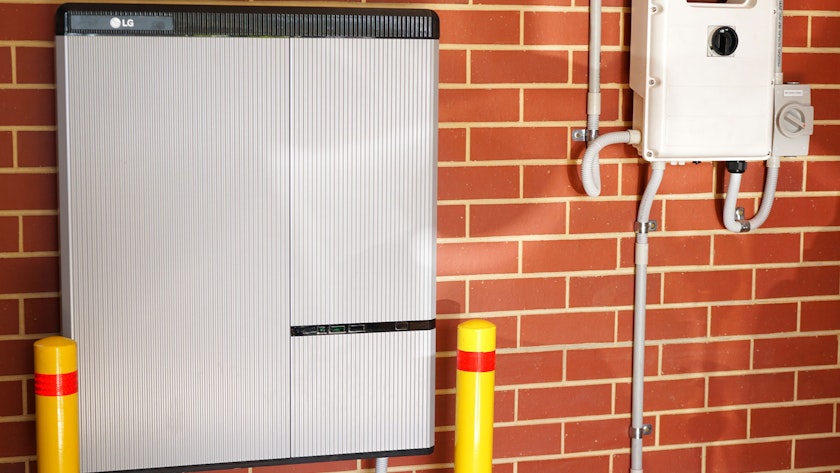
Store and save? Will battery storage cut costs and carbon emissions?
October 27, 2022Home » Store and save? Will battery storage cut costs and carbon emissions?
We will need energy storage and smart controls to reduce the use of gas-fired power stations, by allowing electricity from renewable energy to be stored and fed back to the grid at times of peak demand. Joel Rawson looks at the potential benefits and impacts of one form of energy storage: domestic batteries.
Rising electricity prices mean that storing energy in a battery to use later will save more money than it used to – potentially making a battery a more attractive investment.
However, a careful approach is still required for a decent financial saving and to ensure that the energy and resources invested in manufacture will lead to a worthwhile benefit.
Thinking at the larger community scale is important, as we need energy storage that can buffer the grid between off-peak and peak times, boosting the use of renewable energy. It’s therefore about more than just matching your own energy use.
Carbon impacts
Studies into the carbon footprint of current lithium-ion batteries calculate a figure of around 100kg of carbon dioxide (CO2) per kilowatt-hour (kWh) of battery capacity when manufactured in factories that use fossil fuels. This is reduced to about 60kg CO2 per kWh when renewable energy is used in the manufacture. It can be reduced further with the decarbonising of supply chains for raw materials.
Developing new types of battery chemistry will also help. For example, the campaign group Transport & Environment recently reported the potential for solid state batteries to reduce the carbon footprint to below 50kg CO2 per kWh.
New developments should be alongside efforts to improve the recycling of lithium batteries and reduce the environmental and social impacts from extracting raw materials. Reduced costs and carbon emissions need to be achieved through improved processes, not from driving down labour costs or working conditions or creating other long term pollution problems.

Carbon savings
In carbon terms, the most advantageous use of electricity storage in the UK is to reduce the use of gas-fired power stations, because we’ve virtually eliminated higher carbon coal-fired
power now.
Replacing 1kWh of electricity from gas will avoid emitting about 0.35 to 0.4 kg of CO2. A lithium-ion battery carbon footprint of 80kg CO2 per kWh is about 200 times as much as that. This means the battery needs to be charged from zero carbon energy and then discharged to replace gas use about 200 times for the carbon savings to outweigh the manufacturing impact.
That’s less than one year of use – but in practice not all output from a battery will be directly replacing gas. But it shows the potential for avoiding gas use and the resulting carbon emissions through a combination of renewable energy and energy storage.
A key step to maximise carbon savings is for a battery to be a buffer for the grid, rather than only meeting your own needs. For example, exporting to the grid in early evening, when overall demand peaks and exceeds generation from renewable energy. Ideally, a combination of smart controls and variable rate tariffs would enable you to receive a better export rate at that time – making it more financially attractive to sell the power than keep it for your own use.

Battery life
The expected lifespan of a battery is key to estimating the financial payback. A lithium-ion storage battery warranty is usually for either 10 years or a minimum amount of energy stored (‘throughput’), whichever is reached first. Comparing a few different batteries, the warrantied throughput is around 2500 to 3000 kWh per kWh of storage capacity.
The warranty will also specify an expected reduction in storage capacity after ten years, to about 60% to 70% as much as when new. A battery that originally stored 5kWh would drop to
about 3kWh capacity after a decade of use. Battery life should be a bit longer, depending on usage, but the continued degradation means that the warrantied throughput is a good figure to use when estimating financial savings.
Financial Payback
Lithium-ion battery cost is often around £1000 per kWh of storage, but for larger capacity batteries it can be less (perhaps £700 per kWh).
When electricity prices were about 15 pence per kWh and you could export directly for a few pence per kWh, the net benefit of storing energy to use later may have been only £250 to £300 per kWh of capacity, over about ten years of use. For someone on the old feed-in tariff scheme the export rate might not be a factor, so the saving would have been about £100 to £150 more. Either way, that’s less than the battery cost.
Prices now are much different, although standard export rates are usually still only a few pence. From October 2022 the price cap equated to an electricity cost of about 34p per kWh. However, how much this will change in the next ten years is very hard to say. It could rise further next year, but then drop again.
If the potential saving was about 30p per kWh, then storing 3000 kWh (over the battery life) to use later would add up to about £900. However, if you can export that electricity for a payment instead, the net benefit might be about £750. That’s closer to the battery cost per kWh of capacity, but still marginal. If average prices over the next ten years are lower, say 25p, then the financial payback is not as good.
Imports and exports
Even with higher energy prices, to get a good financial payback from a battery you really need to make use of ‘time-of-day’ tariffs for importing and exporting energy at different rates during the day. And this ties in with the approach mentioned above for maximising carbon savings.
For example, it would involve avoiding imports during the early evening peak. Instead, draw only from solar panels and/or battery at that time. Also, exporting excess energy to the grid at peak times can give a better payback than keeping it to use later. A combination of these should give a much better return than the basic payback calculated above – but exact savings will vary.
Getting a reasonable export price for electricity generated from a solar PV array is important because there are seasonal limits on how much you can use directly. In summer a PV roof rated at 4 kilowatts (kW) should produce about 15 to 20 kWh per day. This is about 2 to 3 times as much as average daily electricity use (or more in a very energy efficient home). You will therefore be exporting most of this electricity – either directly, or later in the day via a battery. Exporting energy is good, as it all contributes to decarbonising the grid.
At the moment you need to be more careful when choosing and using a time-of-day tariff, because soaring wholesale gas prices can mean that any imports during peak periods could be at a very high cost.
Vehicle to grid (V2G)
For electric vehicle (EV) owners, another option could be to make use of their EV battery as a buffer for the grid, using a charger with ‘vehicle-to-grid’ (V2G) capability. Car battery capacities are much higher than domestic batteries – about 40 kWh for smaller cars. On a day when you’re not driving far you could charge on a cheap night rate or from your solar panels, and sell back to the grid for a high rate.
At the moment you can only get a V2G charger through an approved trial. If interested, you could register with some energy providers and car manufacturers to get updates on these. More widespread deployment should be possible soon. Again, the main driver of V2G is the need to buffer grid demand at peak times – with exports triggered by a control unit that communicates with the grid. However, a vehicle-to-home approach is also possible with this sort of technology, as is running other electrical devices from an EV when away from home.
About the author
Joel Rawson is CAT’s Information Officer, providing free and impartial advice on a wide range of topics related to sustainability. He first came to CAT to volunteer in 2001, and graduated with a CAT Postgraduate Diploma in 2013.
CAT’s free information service
Visit our Free Information webpages for information and advice on a wide range of areas related to homes, buildings, energy and more.
Related Pages
EMAIL SIGN UP
Keep up to date with all the latest activities, events and online resources by signing up to our emails and following us on social media. And if you'd like to get involved and support our work, we'd love to welcome you as a CAT member.



